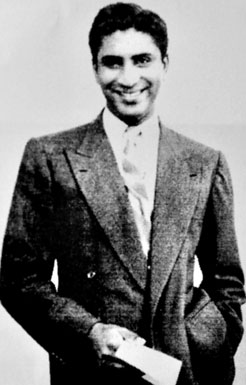Then there were politicians who truly served the people
Gregory’s Road, in the heart of Colombo 7 has its own stately air, with its colonial buildings and tree-lined pavements. On July 16, Gregory’s Road will be renamed R. G. Senanayake Mawatha, in honour of a man who fought hard for the progress of the common man – Richard Gotabhaya Senanayake.
“There’s a dining table in my home on which E. W. Perera signed the famous ‘letter-in-the-shoe’. The Grassmere mansion is where many of the ideals of winning our independence were originated, and my great grand father F. R . Senanayake played a role in it,” says Chathuka Senanayake, grandson of R. G. Senanayake.

Young politician R.G. Senanayake as he was in 1947
Although Chathuka never saw his grandfather, he had heard all about him from his grandmother, the late Mrs. Erin Senanayake. The people of Kelaniya, one of the seats that R.G Senanayake represented would also share stories with him. “They tell me that he was very much involved with the people at the ground level, and that he stayed true to his principles at all times,” says Chathuka.
R.G. Senanayake, born on November 4, 1911, was the son of patriot and philanthropist F. R. Senanayake, brother of D.S. Senanayake. After completing his higher studies at Cambridge University, he was plunged into politics following the unfortunate death of his brother-in-law, Siripala Samarakkody. R.G. filled the vacancy left in the Narammala seat. He quickly won the hearts of the people and was voted in as the Dambadeniya MP in the first Parliament on the eve of Sri Lanka’s independence.
R.G. Senanayake’s strong ties with the Father of the Nation D. S Senanayake no doubt helped his political career. Devinda Senanayake, his nephew, mentions that R.G. Senanayake had a close relationship with D.S., looking up to him as a father figure after the death of his own father.
R.G. was appointed Parliamentary Secretary (now Deputy Minister) to the Ministry of Defence and External Affairs in the first ever Cabinet of Sri Lanka back in 1947. D.S. Senanayake was Minister of Defence and External Affairs and Prime Minister during this period.
When Dudley Senanayake took over as Prime Minister in 1952, R.G. Senanayake was made Minister of Trade and Commerce. His most significant achievement was the Rubber-Rice pact with China. Although the initial ideal had been brewing in D.S’s mind, his untimely demise put paid to any idea of the pact moving forward. R.G. was the one who volunteered to brave the strong tide that opposed the pact. In an era where China was battered by the Korean War, and blacklisted by the world, the Rubber-Rice pact -which bartered our rubber for their rice- came as a blessing for both countries. It would not be wrong to state that the foundations for the fruitful relationship that we enjoy with China now was laid down by R. G. Senanayake.
The world took this as a radical move, and the United States retaliated by cutting off the sulphur supply that was needed for rubber harvesting. However, this was a small price to pay, for the large benefits gained.
As far back as 1952, R.G. foresaw the emergence of China as a world power and stated – “I have always held the view that political ideologies should not stand in the ways of countries trading with each other if that trade is to their mutual advantage. Talking of China in particular, it would be unrealistic to ignore a nation of 500 million in our continent with a united and cohesive government for the first time in many centuries. She is bound to be a major factor in world trade”.
Mahendra Senanayake, a relative, who was one of R.G’s aides remembers him well. “R.G or Dickie Aiya as we knew him, was a man of his word and went out of his way to bring justice to all,” he recalls, adding that though he faced strong opposition, he was steadfast in working towards his goals. Mr. Senanayake recalls 1953 – when J.R. Jayewardene as Minister of Finance, introduced a budget that abolished the rice subsidy, sending the price of a measure of rice skyrocketing from 25 cents to 70 cents. “Dickie Aiya was suffering from polio at that time, but he went to Dudley Senanayake, the Prime Minister, and pleaded with him not to increase the price of rice saying that he would even get down on his knees if he could.” The counter-argument was that it would help a largely subsidy-dependent population to earn for themselves. However, the move resulted in the 1953 riots or Hartal.
“R.G. was a man who worked for the common man and was dedicated to that cause throughout his life,” says Mr. Senanayake.
R. G. Senanayake left the United National Party, and contested from the Sri Lanka Freedom Party in 1960, later standing as an independent candidate in 1965. On both occasions he had resounding victories, retaining his Dambadeniya seat. In 1968, he founded the Sinhala Mahajana Party, and voiced the concerns of the Sinhalese and Buddhist monks.
He died on December 22, 1970. R. G. Senanayake will be remembered as one of the stalwarts of an era when politics meant service to the people.
Follow @timesonlinelk
comments powered by Disqus


